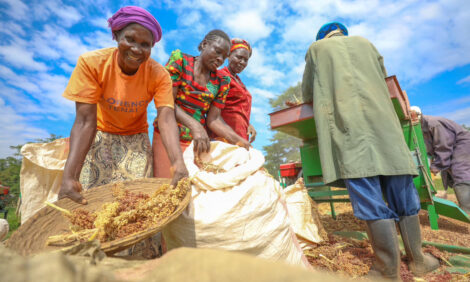



Weekly global protein digest: Canada reports backyard HPAI outbreak, Iowa pushes for faster HPAI vaccine approval amid export concerns
Livestock analyst Jim Wyckoff reports on global protein reportsAwaiting the Trump administration’s HPAI/egg plan
Kevin Hassett, the National Economic Council Director, is expected to release his plan to address the highly pathogenic avian influenza (HPAI) outbreak and egg prices by the end of this week. Hassett previously mentioned that he is currently editing the plan with his team, suggesting it is in its final stages of preparation. The plan is expected to be ready for President Donald Trump this week. Hassett and USDA Secretary Brooke Rollins are working with experts from government and academia to have the plan ready for President Trump. The plan aims to implement a "smart perimeter" approach with improved biosecurity measures and medication strategies to control the spread of avian flu without resorting to mass culling of chickens.
US egg imports rose by 38% in December 2024 compared to the previous month
This indicates a broader trend of increased imports from multiple countries. U.S. firms have been seeking alternative import markets due to supply constraints, suggesting that other countries besides Turkey may have increased their egg sales to the U.S. As Turkey is redirecting some of its exports from other markets to the U.S., it's possible that those markets are now sourcing eggs from different countries, potentially creating a ripple effect in global egg trade.
Top egg exporters globally include:
- Netherlands: The leading exporter, with $610.1 million worth of fresh egg exports, accounting for 20.5% of global exports.
- Poland: The second-largest exporter, with $463.4 million in exports, representing 15.6% of the global market.
- Turkey: Ranking third globally with $224.5 million in exports (7.5% of the global market), it actually experienced a 6.6% decrease in exports from 2022 to 2023.
- China: Ranking fourth globally, China exported $222.8 million worth of eggs, constituting 7.5% of world exports.
- Germany: The fifth-largest exporter, with $181.5 million in egg exports, making up 6.1% of the global market.
Other significant egg exporters include: - Malaysia
- Belgium
- Spain
- India
- Ukraine
- Thailand
Iowa leaders push for faster bird flu vaccine approval amid export concerns
Iowa Gov. Kim Reynolds, along with U.S. Sens. Chuck Grassley (R-Iowa) and Joni Ernst (R-Iowa), are urging USDA to accelerate the approval of animal vaccines for bird flu. However, poultry trade groups oppose the move, arguing that vaccines could mask symptoms, prompting trade bans on US poultry exports. Many countries, including China and the European Union, ban poultry imports from nations that vaccinate against avian influenza. The concern is that vaccinated birds can still carry and spread the virus asymptomatically. That makes it harder to detect and control outbreaks. If the US poultry industry widely adopted vaccination, it could risk losing access to billions of dollars in export revenue. They also cite the high cost and logistical challenges of mass vaccination. Most avian flu vaccines require individual injections, making them impractical for large-scale poultry farms in the US, where flocks can number in the tens or even hundreds of thousands of birds.
Of note: Between 2013 and 2022, about 17% of US chicken production was sent to other countries, making it the most export-focused poultry product. In 2024, US poultry meat exports (excluding eggs) were worth around $5.53 billion, with an average of $5.66 billion over the past three years.
USDA works to rehire FSIS staff amid new HPAI strategy rollout
USDA’s Food Safety and Inspection Service (FSIS) is working to rehire several staff members mistakenly fired over the weekend despite their role in the agency’s response to highly pathogenic avian influenza (HPAI). USDA confirmed efforts to rescind the termination letters but did not indicate similar action for the Animal and Plant Health Inspection Service (APHIS). Meanwhile, USDA is finalizing a new HPAI strategy, focusing on enhanced biosecurity and surveillance measures to curb outbreaks without mass poultry culling. The plan, involving National Economic Council Director Kevin Hassett and USDA Secretary Brooke Rollins, is expected to be reviewed by President Donald Trump before its official release.
USDA maintains Mexican cattle imports despite screwworm case
USDA will not reinstate restrictions on cattle imports from Mexico after another case of New World screwworm was detected in a cow in Tabasco state. USDA had previously banned Mexican livestock shipments in November but lifted the restriction on Feb. 1 under new pre-clearance protocols. The pest, which can cause severe damage to livestock, wildlife, and occasionally humans, has raised concerns among traders, briefly boosting feeder cattle futures. Despite the latest detection, USDA affirmed that its inspection and treatment protocols ensure safe cattle movement into the U.S. amid historically low domestic supplies.
Canada reports HPAI outbreak in backyard flock
Canada has reported an outbreak of highly pathogenic H5N5 avian influenza on a non-commercial backyard layer poultry farm in the eastern part of the country, the World Organization for Animal Health (WOAH) said. Analysis of the H5N5 virus detected in Canada’s Newfoundland and Labrador province showed it was similar to the H5N5 one which hit Canada in 2023, the Paris-based WOAH said. It also showed that it was related to the H5N1 (2.3.4.4b) lineage that has affected some farms in Canada and has been spreading in other parts of world, mainly in the United States and Europe.
Weekly USDA dairy report
CME GROUP CASH MARKETS (2/14) BUTTER: Grade AA closed at $2.3775. The weekly average for Grade AA is $3.3985 (-0.0115). CHEESE: Barrels closed at $1.8175 and 40# blocks at $1.9200. The weekly average for barrels is $1.8215 (+0.0245) and blocks $1.9140 (+0.0455). NONFAT DRY MILK: Grade A closed at $1.2800. The weekly average for Grade A is $1.3010 (-0.0370) DRY WHEY: Extra grade dry whey closed at $0.5550. The weekly average for dry whey is $0.5675 (-0.0380).
BUTTER HIGHLIGHTS: While some butter contacts report demand varies from moderate to steady, a few other stakeholders describe butter demand as seasonally slow for this week. Plenty of affordable cream is available for butter manufacturers. All three regions had the bottom end of their All-Class cream multiples move further below 1.00 this week, with some very low offers for distressed cream loads. Butter manufacturers are busy working affordable cream volumes through butter churns. Bulk butter overages range from 5 cents below to five cents above market, across all regions.
CHEESE HIGHLIGHTS: Cheese production schedules are generally steady to stronger throughout the U.S. In the East region, cheesemakers relay snug milk availability. Cheese production is noted to be steady, and cheese inventories are generally available. Retail and foodservice demand are steady to stronger. In the Central region, milk availability varies from area to area. Spot milk prices range from $2 under Class III to flat Class. Cheese demand notes are mixed. In the West region, cheese manufacturers share steady to stronger production schedules. Some manufacturers relay tighter inventories than others. Cheese demand is steady from the retail sector and steady to lighter from the foodservice sector.
FLUID MILK HIGHLIGHTS: Fluid milk volumes at the farm level are mixed this week. Lighter volumes are being reported from handlers in the Pacific Northwest, while steady volumes are being seen in the Northeast. Both regions are pointing to weather factors as a hurdle to aiding in cow comfort this time of year. Farmers in the Central, Southeast and Southwest regions of the country are reporting strengthening fluid numbers. There has been little change in demand for milk this week. Class I demand is holding strong as bottlers maintain their production schedules. Class III demand is steady in all regions. Cheesemakers reported spot milk prices between $2-under to Class III. Condensed skim supply and demand are both mixed this week. Demand is steady in the East where supplies are snug. However, demand in the West is strong where more ample supplies can be found. The cream market is the counterpoint to the milk and condensed skim markets. Cream volumes are plentiful in all regions. Contacts say weeks of strong component levels and plant downtime are just a couple of factors contributing to plentiful volumes of cream afloat in the U.S. Butter churns are busy across the nation, and many processors report loads of cream are stacking up and waiting for processing. Cream demand from other Classes is ticking up, but they have not yet made a substantial impact on cream deposits. Cream multiples for all Classes range 0.85-1.10 in the East region, 0.50-1.14 in the Central region, and 0.55-1.10 in the West region.
DRY PRODUCTS HIGHLIGHTS: A majority of dry dairy ingredients markets are under bearish pressure again this week. Growth in availability and lighter international and domestic demand are catalysts for some bearish markets. Low/medium heat nonfat dry milk prices slipped in all regions. Dry buttermilk prices decreased in the Central and East, while holding steady in the West. In the East and Central regions, dry whey prices dropped, while the West dry whey price range expanded. Lactose prices were steady to slightly higher. Whey protein concentrate 34% continued its resilient run this week, as prices continued to move higher on strong demand and tight supplies. Dry whole milk prices dropped. Acid casein prices were steady to lower, while rennet casein prices held steady.
INTERNATIONAL DAIRY MARKET NEWS
WEST EUROPE: Ireland's Central Statistics Office estimates total milk intakes by processors and cooperatives in December 2024 at 267.1 million liters. The UK-based Agriculture and Horticulture Development Board (AHDB) released data showing daily milk deliveries for the week ending February 2 averaged at 33.75 million liters, down 0.2 percent from the week prior but up 1.9 percent from the same week last year. No additional cases of foot and mouth disease (FMD) have been detected in Germany since the initial case was confirmed in a herd of water buffalo in Brandenburg, Germany on January 10.
EAST EUROPE: The European Commission Combined Drought Indicator lists warning drought conditions in pockets of East Europe due to precipitation deficits, while other areas are in recovery drought conditions or normal conditions. AUSTRALIA: Dairy Australia recently released export data for Australia showing milk export volumes from July 2024 -December 2024 were 84,898MT, down 16.3 percent from the same time period a year earlier.
NEW ZEALAND: A financial institution recently released a report discussing expectations for agriculture in New Zealand in 2025. The financial institution forecasts 2025 milk production will increase in New Zealand by 0.8 percent from the prior year. A group in New Zealand, which forecasts dairy prices, increased the forecasted milk price for the 2024/2025 season, following GDT event 373, by 16 cents, to $10.11/kgMS. The spot value of milk also increased by 38 cents to $11.66/kgMS. The group stated the primary fac-tor contributing to increased prices was the strong results for all commodities traded at GDT event 373.
SOUTH AMERICA: Milk output in the South American region varies. Uruguayan contacts reported some positives regarding expectations even during the summer months. Meanwhile, in Argentina and Brazil, output is less bullish. The WASDE report from February 11 cut corn estimates in both countries based on heat, dryness and delayed early-season corn planting.
US NATIONAL RETAIL REPORT: Total conventional dairy advertisements decreased by 12 percent while total organic dairy ads increased by 7 percent. Conventional ice cream in 48–64-ounce containers was the most advertised dairy product, with a weighted average advertised price of $4.25, up from $3.94 the week before. Organic half gallons of milk were the most advertised organic item overall and had a weighted average advertised price of $4.94, up from $4.64 last week. Conventional butter in one-pound packages had a weighted average advertised price of $4.62, up from $4.00 the week prior.









